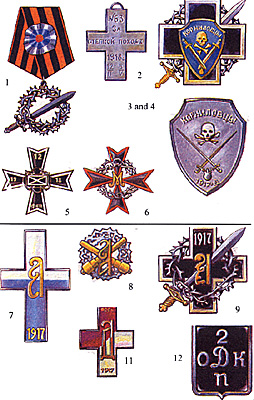
Badge of the First Kuban (Ledyaniy) Campaign - for the march to Kuban of the Dobrovol'cheskiy Army (All Volunteer Army of South Russia or VSYuR) combined with a Detachment of General Pokrovskiy (numbering nearly 2000 men). The Dobrovol'cheskiy attacked Ekaterinodar (Krasnodar), but lost the battle and L.G. Kornilov was killed. The White Army left Ekaterinodar in flames. General A.I. Denikin replaced Kornilov. The Wreath is silver and 30mm in diameter and the silver sword is 50mm long. This badge was awarded to everyone who took part in the battle against the Bolsheviks. (picture #1)
Cross for the Steppes Campaign - Don Cossacks received this after the battles of New Cherkassk and Rostov in February 1918. Ataman Popov united with the Dobrovol'cheskiy Army for the Kuban Campaign. The cross - vertical bar is 11mm by 37mm and the horizontal bar is 13mm by 34mm. The cross is made of iron. (picture #2)
Medal and Badge of the Kornilov Shock Regiment - The foundation of the Kornilov Shock Troops is found, not in the Russian Civil War (RCW), but in WWI from 1914 to 1917. General Kornilov commanded the 8th Army and the Shock Regiment was initially formed as the Shock Detachment with a Captain Nezhentsev commanding. The Detachment consisted of two battalions of 1000 men each, 3 machinegun commands, and one reconnaissance command (some mounted, some on foot). After the break up of the Russian Army - 600 Kornilovtsi went to the Don and reestablished the Shock Regiment. The Medal is stamped silver, 25mm by 35mm, the back side is smooth. The Badge is silver and enamel with gold highlights (size is approximately 50mm by 50mm). (pictures #3 and #4)
Badge of the 1st Officer's Infantry of General Markov Regiment. Like the Kornilov Shock Regiment, the Markovs also found their tradition in bravery and duty. But, because of the times, a young commander (and he was only 25 years old) and young troops, the Markovs degenerated and were known as thieves, scandalists, drunks, and gamblers. Duels were a common affair in the Regiment.
The White Army was unlucky for its commanders. Kaledin - shot. Kornilov - killed by a bullet. Markov - killed in battle. Drozdovskiy - killed in battle. Krymov - shot. Chernetsov - killed in battle. Dukhonin - killed. Keller - shot. Dutov - died. Bulak-Bulakhovich - killed. Kolchak - shot.
The Badge is a silver Maltese Cross with black enamel. (picture #5)
Badge of the Markov Artillery Division - gold Maltese Cross with black enamel. (picture #6)
Badge of the Alekseev Infantry Regiment - February 1918, in Ol'ginskiy, gathered humanists, realists, and students, who to that time, had fought the war as partisan detachments. By 26 September, 1918, the unit was called the Partisans of General Alekseev Regiment. Only after 20 years (22 December 1939) was the Badge of the Alekseev Regiment established. It was white metal, 4cm by 6cm. (picture #7)
Badge of the Alekseev Artillery Division - in June 1919, the Partisans of General Alekseev Regiment became a Division, consisting of two Regiments and an Artillery Brigade. In the Crimea in 1920, the Brigade became an Artillery Division. The badge was established on 17 June 1936. Gold cannons on a silver wreath. (picture #8)
Badge of the 1st Horse of General Alekseev Regiment - the regiment was formed on the return from the 1st Kuban (Ledyanov) Campaign and took part in the 2nd Kuban Campaign to the Donbass.
A.I. Denikin declined the offer of P.N. Krasnov to unite with the Germans and together with them, attack Tsaritsyn. In June 1918, Denikin marched to Kuban in order to pick up the Cossacks there, but the Cossacks weren't going to leave their land. This allowed Krasnov to take Tsaritsyn. After this, the Cossacks refused to attack Tsaritsyn. They considered that the Don would not save Russia and that this was Russia's problem (and not theirs). So the Cossacks withdrew 50 kilometers from Tsaritsyn and the front was breached.
During this time, the Dobrovol'cheskiy Army seized Tikhoretskiy, Stavropol', Ekaterinodar, and Novorossiysk. The Alekseev Regiment took part in all these battles, and after the Whites took Kursk, they established the 1st Brigade of the 10th Cavalry Division.
The Badge is a silver cross with white enamel (no size is given). (picture #9)
Badge of the 2nd Officer's Rifles of General Drozdovskiy Regiment - after uniting on 27 May 1918, those who came from the Yassa with the Dobrovol'cheskiy Army were divided into the 3rd Division, 2nd Officer's Rifles Regiment. General Drozdovskiy was seriously wounded in battle and died on 1 January 1919. In memory of their commander, they became the 2nd Officer's Rifles of General Drozdovskiy Regiment. The Badge is a gold cross, 3cm by 2cm with raspberry enamel. Left and lower - white enamel. (picture #11)
Badge of the 2nd Officer's Horse of General Drozdovskiy Regiment - also formed from those who came from Yassa in May 1918. They received their name after General Drozdovskiy perished. The badge was for all who emigrated from Yassa, but for these soldiers, they wore the same emblem on their left shoulder sleeve. The Badge is silver with black enamel and silver letters. (picture #12)
Russian Civil War 1917-1922 White Army Badges and Decorations
Color Illustration 1 (83K)
Color Illustration 2 (111K)
Back to The Gauntlet No. 18 Table of Contents
Back to The Gauntlet List of Issues
Back to Master Magazine List
© Copyright 2000 by Craig Martelle Publications
This article appears in MagWeb (Magazine Web) on the Internet World Wide Web.
Other military history articles and gaming articles are available at http://www.magweb.com